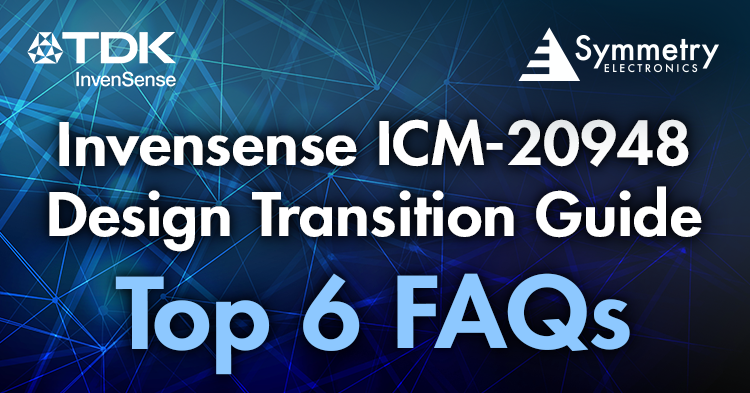- Home
- Symmetry Blog
- Invensense ICM-20948 Design Transition Guide:
Invensense ICM-20948 Design Transition Guide:
Top 6 FAQs
About Augustine Nguyen

1.Why is the ICM-20948 no longer recommended for new designs (NRND)?
The ICM-20948 is a 9-axis IMU that integrates the TDK 6-axis ICM-20648 (accelerometer and gyroscope) and AKM’s AK09916C external magnetometer. Since AKM is discontinuing production of the AK09916C mag, TDK Invensense is not able to guarantee the long-term supply of the ICM-20948 due to the limited supply of the AKM magnetometer wafers.
2.Is the ICM-20948 going to be discontinued and if so, when?
TDK Invensense currently does not have a plan for end-of-life (EOL) the ICM-20948. As part of its EOL process, InvenSense gives 6 months of advance notice before the product is no longer orderable.
3.What Product Numbers does TDK recommend as an alternative to the ICM-20948? What are some of the differences?
As alternatives, TDK Invensense recommends their latest generation sensors:
- The ICM-42670-P
- The ICM-42688-P
While these flagship sensors from TDK have improved hardware and power performance over the ICM-20948, there are some major differences (Figure 1) as highlighted below:
- The ICM-20948 is a 9-axis IMU (accelerometer, gyroscope, and magnetometer). The ICM-42670-P and the ICM-42688-P are 6-axis IMUs only (accelerometer and gyroscope).
- With the ICM-426xx series, TDK transitioned from the DMP architecture of the ICM-20948 to the APEX architecture. The advantage of the APEX is that the firmware is pre-loaded while the DMP requires the driver to load its firmware at every power-on initialization. There are also differences in the supported motion features that the embedded engines have (see table below), the biggest being that the APEX does not have on-chip sensor fusion or calibration like the DMP.
Figure 1: Embedded feature specifications of the ICM-20948, ICM-42670-P, and ICM-42688-P.
Source: TDK Invensense ICM-20948 Transition Guide
4.What if my design still requires a 9-axis IMU? What discrete magnetometer does TDK recommend?
If your application still requires a 9-axis IMU, you will need to integrate an external discrete magnetometer. Magnetometers from AKM’s AK0991x series (like the AK09915 and AK09918) are commonly found in TDK evaluation kits & software development kits (SDK). Magnetometers from AKM will already be supported by TDK’s example drivers and sensor fusion algorithms. TDK also recommends the latest magnetometer from AKM, the AK09919C. Other discrete magnetometers from different suppliers will require driver development since the ICM-426xx example drivers only support AKM recommended parts.
5.How exactly does the ICM-20948 compare to the ICM-426xx series in terms of sensor specs and performance?
The specification comparison table (Figure 2) from TDK Invensense ICM-20948 Transition Guide highlights the differences in the sensors’ performance parameters.
Figure 2: Specification comparison chart for the ICM-20948, ICM-42670-P, and ICM-42688-P.
Source: TDK Invensense ICM-20948 Transition Guide
6.Will I need a PCB layout change to transition out of the ICM-20948?
Yes, a PCB change will be required because the ICM-20948 (24-pin 3x3 QFN) is not pin-to-pin compatible with the ICM-42688-P or the ICM-42670-P (14-pin 2.5x3 LGA). If an external magnetometer is required for your design, you will need to add it and connect it to the application processor.



